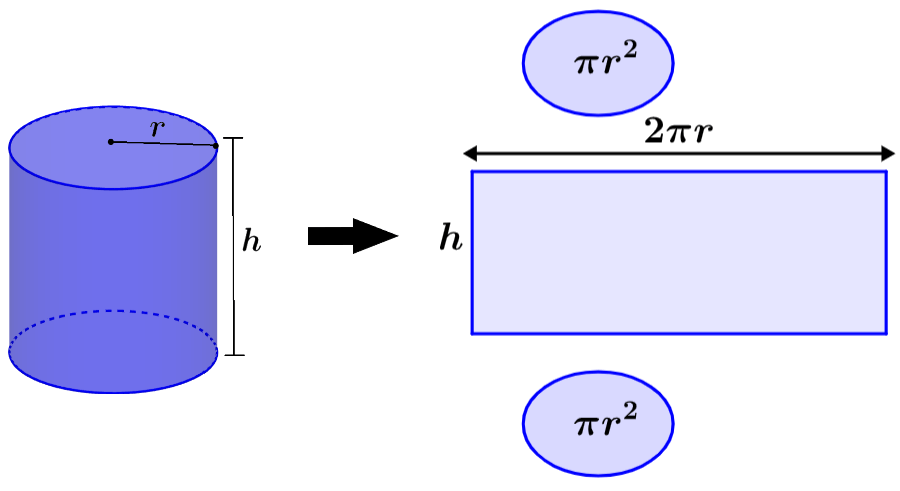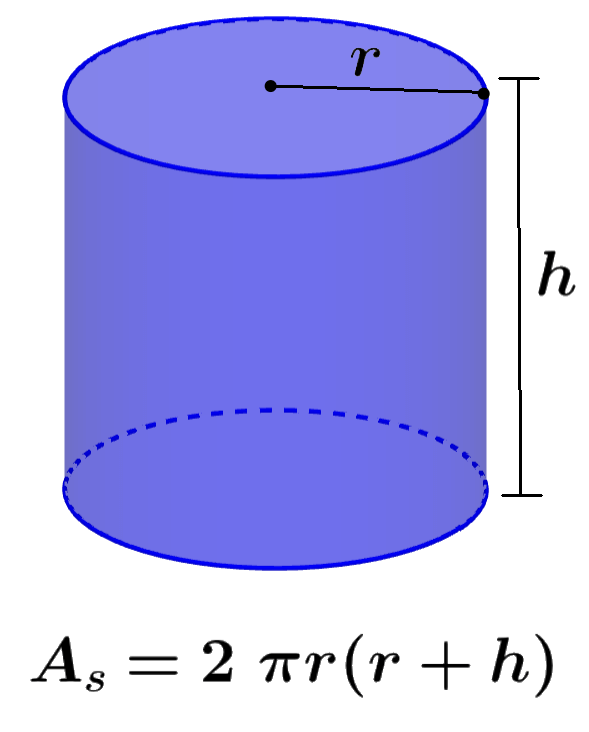The surface area of a cylinder is equal to the area occupied by its surface in three-dimensional space. A cylinder is a three-dimensional geometric figure that has two circular bases that are parallel to each other. We know that a cylinder is composed of two circular bases and a surface that covers the two bases. Therefore, the surface area of the cylinder equals the area of the two circular bases plus the area of the curved surface. The surface area is represented in square units, for example, m².
Here, we will learn about the formula that can be used to calculate the surface area of cylinders. In addition, we will look at some examples in which we will apply this formula to find the answer.
Formula to find the surface area of a cylinder
The total area of a cylinder is made up of the following parts:
- Area of bases
- Area of curved surface
Area of bases
The base of a cylinder is a circular figure. Therefore, we can use the formula for the area of a circle. Since we have two circular bases, the total area of the bases is:
$latex \text{Area of bases}=2\pi{{r}^2}$
Area of curved surface
The area of the curved surface is given by the area covered between the bases of a cylinder that has a radius “r” and a height “h“. This area is also known as the lateral surface area. We can find this area with the following formula:
$latex \text{Lateral area}=2\pi r h$
Total surface area of cylinder
The total surface area of a cylinder is equal to the sum of the area of the two bases plus the area of the curved surface. Therefore, we have:
| $latex A_{S}=2\pi {{r}^2}+2\pi r h$ or $latex A_{S}=2\pi r(r+h)$ |
where $latex A_{s}$ represents the surface area of the cylinder, r represents the length of the radius, and h represents the length of the height.

Surface area of a cylinder – Examples with answers
The following examples are solved using the formula for the surface area of cubes. It is recommended that you try to solve the problems yourself before looking at the answer.
EXAMPLE 1
What is the surface area of a cylinder that has a radius of 5 m and a height of 8 m?
Solution
We have the following values:
- Radius, $latex r=5$
- Height, $latex h=8$
We use the formula for surface area with these values:
$latex A_{S}=2\pi r(r+h)$
$latex A_{S}=2\pi (5)(5+8)$
$latex A_{S}=2\pi (5)(13)$
$latex A_{S}=408.4$
The surface area is 408.4 m².
EXAMPLE 2
A cylinder has a height of 7 m and a radius of 6 m. What is its surface area?
Solution
From the question, we can get the following:
- Radius, $latex r=6$
- Height, $latex h=7$
We plug these values into the formula for surface area:
$latex A_{S}=2\pi r(r+h)$
$latex A_{S}=2\pi (6)(6+7)$
$latex A_{S}=2\pi (6)(13)$
$latex A_{S}=490.1$
The surface area is 490.1 m².
EXAMPLE 3
If a cylinder has a height of 12 m and a radius of 8 m, what is its surface area?
Solution
We have the following values:
- Radius, $latex r=8$
- Height, $latex h=12$
We use these values in the formula for surface area:
$latex A_{S}=2\pi r(r+h)$
$latex A_{S}=2\pi (8)(8+12)$
$latex A_{S}=2\pi (8)(20)$
$latex A_{S}=1005.3$
The surface area is 1005.3 m².
EXAMPLE 4
If a cylinder has a diameter of 6 m and a height of 7 m, what is its surface area?
Solution
In this case, we have the diameter instead of the radius. However, we can get the radius simply by dividing the diameter by 2. Therefore, we have:
- Radius, $latex r=3$
- Height, $latex h=7$
Using the formula with these values, we have:
$latex A_{S}=2\pi r(r+h)$
$latex A_{S}=2\pi (3)(3+7)$
$latex A_{S}=2\pi (3)(10)$
$latex A_{S}=188.5$
The surface area is 188.5 m².
EXAMPLE 5
What is the surface area of a cube that has a diameter of 12 m and a height of 13 m?
Solution
Similar to the previous exercise, we divide the diameter by 2 to obtain the radius. Therefore, we have:
- Radius, $latex r=6$
- Height, $latex h=13$
Using these values in the formula for surface area, we have:
$latex A_{S}=2\pi r(r+h)$
$latex A_{S}=2\pi (6)(6+13)$
$latex A_{S}=2\pi (6)(19)$
$latex A_{S}=716.3$
The surface area is 716.3 m².
Surface area of a cube – Practice problems
Use the following problems to practice using the formula for the surface area of cubes. If you need help with this, you can look at the solved examples above.
See also
Interested in learning more about cylinders? Take a look at these pages:




